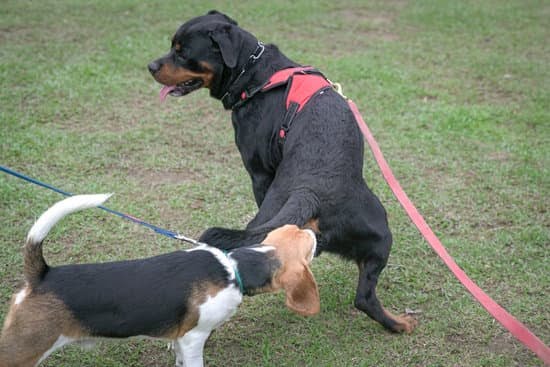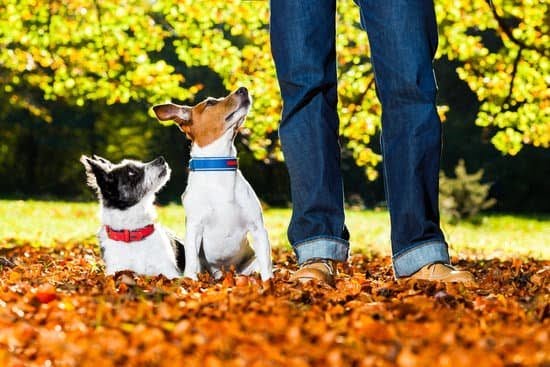Introduction to the Topic
Training a dog by yourself can be both rewarding and challenging. It takes patience, consistency and lots of hard work; however, the rewards of having a well-trained pet is definitely worth it. You must be ready to commit the time and energy necessary to teach your dog the desired behavior you expect from them. It’s important to remember that humans and canines don’t always speak the same language, so establishing a bond between you and your canine companion as well as understanding their behavior will go a long way in successfully training your pup.
The first step to successful doggy training is consistency. If expectations for certain behaviors are not consistently enforced it can lead to confusion for the pup and make training more difficult. Establishing regular cues or commands such as “sit” or “stay” is an essential part of reinforcing good behavior, but positive reinforcement should also be used when possible as this provides incentive for the pup to follow through with desired behaviors.
It’s important to remain patient throughout the training process. Not every pup will learn commands immediately, it may take several repetitions before they correctly understand how they’re expected to behave. Knowing when to provide rewards or corrective responses is key in effectively teaching good behavior while minimizing destructive habits or aggression issues in dogs. Additionally, committing to regularly scheduled sessions rather than one long session at once can help ensure that both you and your furry friend stay engaged throughout the learning process.
In conclusion, although solitary dog training takes dedication on behalf of the owner, it’s also incredibly rewarding when you witness your pup properly displaying desired behaviors. Maintaining an open line of communication between pet owner and pup alike is essential in ensuring success along with staying consistent, patient and providing regular reinforcements throughout the training process.
Pros and Cons of Training Your Dog by Yourself
Pros:
1. You have total control over your dog’s development. As the person training your dog, you will be able to determine which behaviors and commands to focus on, what areas need improvement, and even when it’s time to move onto something new.
2. Training your dog yourself can be more cost-effective in the long run than investing in classes or private lessons with a professional trainer.
3. Doing the training yourself allows you to build a strong bond between you and your pup as it deepens the trust you each have of one another
Cons:
1. Training dogs can be frustrating for first-time owners who are unfamiliar with canine behavior or lack confidence in their ability to train them properly. Without knowing how to apply patience and consistency, results may take longer than necessary or not happen at all!
2. It is difficult to identify mistakes within your own technique while training, due to being too close to the situation itself – having an inexperienced eye might cause unwanted confusion as it will link learning and obedience with incorrect behavior in some cases too repetitively..
3. Not everyone has enough spare time or knowledge of training techniques, therefore lacking both dedication and commitment is an inevitable difficulty when trying alone without professional help.
Key Considerations When Training Your Dog
Training your dog is all about understanding how to effectively communicate with them. This can be difficult when training your dog by yourself, as you will be the only one setting expectations and boundaries for them. As such, it is important to approach the process in a positive, patient, and consistent manner with lots of love and rewards. It’s also important to give your pup plenty of opportunity to practice – especially in distractions – so they learn what is expected of them in any new environment or situation. Additionally, if they are having difficulty understanding the task at hand, consider breaking it down into smaller steps so that learning becomes easier and less overwhelming for them. Finally, never forget to make sure you stay consistent with rewards and praise as this helps maintain their interest in learning new commands.
Tips and Tricks for Successful Dog Training
Training your dog by yourself can be challenging, but it is not necessarily hard. By following some straightforward and effective tips and tricks for successful dog training, you can make the process easier without having to enlist the help of a professional.
The first step in any successful training plan is to be consistent in your approach. Give your dog clear instructions and stick with them – if you say something, follow through with it. This will help your pup understand what is expected of him. Additionally, create a positive training environment: use plenty of praise and rewards when he listens to you or performs a desired behavior to reinforce his good habits.
It’s also important to start small with basic commands like sit and stay so that your pup has an easier time understanding them and building on them as he learns. Breaking up longer tasks into shorter ones can also help keep his attention span, while allowing him to practice at shorter intervals over a period of time may improve the lesson retention rate compared to trying it all at once.
Finally, remember that practice makes perfect! Don’t be discouraged if learning new commands does not happen overnight; it takes repetition before any command is firmly ingrained in your pet’s memory. With patience and dedication, however, you will get there in the end – good luck!
Recommended Supplies for Training
Training your dog by yourself can be a difficult task and requires great patience and dedication. However, it is not an impossible feat! To make the process easier and more successful, you will need to make sure you have the right supplies for training. Some essential supplies include a good quality treats (such as soft , bite-size treats that your dog will find irresistible), suitable toys to reward them with (for example squeaking or chew toy) and lastly, a well-fitted collar with a leash so you can keep your dog safely controlled during sessions. It is also important to have training pads on hand in case of any accidents that occur while housebreaking. If there are certain commands you would like your pup to learn such as sit, stay, come or lie down, then having a clicker device can help reinforce desired behaviour when paired with the other rewards mentioned above. With a strong sense of perseverance and dedication towards training alongside the necessary supplies, success can be achieved!
How to Interpret Your Dog’s Fleeting Signals
Training your dog can be a challenge. It often takes patience, focus, and consistency in order to effectively do so. Without assistance from a professional trainer or an experienced individual, the process of teaching your dog can be tedious and difficult. Additionally, it is important to learn how to interpret your dog’s fleeting signals to enable successful and effective training. By studying the body language of your pup – such as their facial expressions, their eyes, their posture and tail and so on – you can gain insight into their emotional state in order to better understand how they may react during a certain scenario or upcoming instruction. That being said, by understanding these more minute details you can create a sound reward system which will ultimately help motivate your pup during training sessions. Therefore, training your dog by yourself can require plenty of progress over time but is feasible with enough dedication and effort along with an acute eye for reading canine gestures correctly.
Analyzing Your Dog’s Capabilities
Training your dog by yourself can be hard depending on the dog’s capabilities. It’s important to take an honest look at your pup and assess their individual needs and training style; while some breeds may be easier to train, they might not respond well to certain techniques. To ensure training success it’s helpful to observe how the dog learns best – are they visual learners, or do they respond better when given verbal commands? How do they react when being corrected? Are they naturally enthusiastic about learning or bored quickly?
Keeping in mind that every dog is different, there are some common tips for successful training regardless of breed. Making sure that practice sessions are shorter but more frequent can help keep your dog’s attention throughout the process; this boost in motivation will lead to a faster learning curve as well as improvement of behaviors. Additionally, dispensing rewards and praise for good behavior is key for letting the pup know what will get them prizes — after all, everyone enjoys positive reinforcement! With patience and lots of love, you and your four-legged friend will accomplish great things together.
Defining a Course of Action
No matter your goals for training, successfully teaching your dog requires patience and consistency. It’s important to create a consistent training routine, as dogs learn best in predictable environments with established expectations. This includes dedicated times for feeding, potty breaks, play sessions, and of course—training. Before you even begin the process of teaching commands to your pup, it’s essential to take time to get on the same page with your pet. Take the first few training sessions – or even the first week – to become familiar with one another and make sure everyone is comfortable throughout the process. During those initial meetings, focus on getting your pup accustomed to having you handle them and being rewarded for following positive behaviors instead of performing negative actions. Additionally, having realistic expectations can greatly improve results over time. Don’t expect overnight success – all pets learn at their own pace – but every small victory should be greeted with enthusiasm and reward! Lastly, remember that training isn’t limited to scheduled times; anytime during the day is an opportunity for education if done correctly. Eventually dogs will realize that good behavior brings rewards no matter what environment they are in!
Archiving Your Dog’s Progress
Training your dog by yourself can be very challenging, but it is also very doable. With proper knowledge and dedication to the process, your dog can learn new behaviors and respond to commands efficiently. Keeping track of the progress you make is important in any successful training program. It can help show how far you have come, create a plan for continued improvement, and gauge what areas may need additional attention. An easy way to keep track of progress is through a log book. Write down each obedience session and detail the different behaviors that were attempted along with each response from your pooch. After each session, reflect on what worked well and what needs more practice or needs adjusting so that you can build upon it during upcoming sessions. It’s also useful to have a form that records when behaviors are mastered so that reinforcement for those behaviors continues following their completion. For longer term tasks like house-training, keeping track of times of day, successes and accidents helps to pinpoint cycles and prompt developments that may improve future performance. Tracking your dog’s progress will help you know just how much work is paying off in the long run!
Rewards for Good Behavior
Training a dog requires a lot of patience, consistency and effort. It can be hard to train your pup on your own, however it is not impossible. The most important thing you need to remember when training your dog is that rewards are an effective way to promote good behavior. You may choose to use treats as rewards or verbal encouragement such as “good job” or “great job” while praising your pet after they successfully complete the command. Providing positive reinforcement will help your dog learn more quickly and make the process of training much smoother for both you and your pup. Additionally, avoiding punishment and never using physical discipline during the training helps ensure that the end goal of teaching desired behaviors is met without negatively impacting your relationship with your four-legged friend.
Common Mistakes Made When Training
Training your dog by yourself can definitely be a challenge, as both consistency and patience are key components. It is important that you set goals for both yourself and your dog to ensure the training is successful. Some of the most common mistakes when training your dog are not being consistent in rewards, not providing enough stimulation or boredom during training sessions, failing to structure or limit behavior, or even going at too much of a rapid pace. Additionally, incorrect timing with rewards and punishments can have negative consequences on the success of training. Be sure to step away from the training if it appears too overwhelming in order to reset so progress can continue at a comfortable pace.
Advice for Struggling Trainers
Training a dog by yourself can be a difficult and daunting task. It takes commitment, consistency, knowledge, and patience to do it the right way. However, all the hard work is absolutely worth it when you see the wonderful results of your pup’s training. Here are some tips for struggling trainers who want to train their dogs themselves:
1. Establish a Routine: A consistent schedule will help your dog learn faster and make them feel more secure in their environment. Additionally, setting clear boundaries and expectations also helps in training.
2. Tasks Should Be Age-Appropriate: When teaching new skills, start with tasks that are age-appropriate for your pup so they can focus better. Give rewards as soon as they master each skill and slowly increase difficulty levels as your pup improves over time.
3. Stay Positive: It is important to keep a positive attitude throughout the entire training process and always correct bad behavior positively with verbal commands or treats—never punishment!
4. Set Realistic Goals: It is easy to become frustrated when teaching something new; be sure to set realistic goals that are achievable within reasonable timelines so that you don’t overwhelm your pup or yourself during the process.
5. Have Fun: Always remember that this is an activity you should enjoy doing with your pup! They will recognize when you get frustrated or impatient and may act out more if they sense this negativity from you; keep things lighthearted and fun while learning something new together!
Tips for Reaching Final Goals
Training your dog by yourself is not always easy. There are, however, some tips that you can use to help reach your goals.
First of all, break down tasks into smaller pieces. Trying to tackle everything at once is overwhelming and can lead to frustration. Most dogs cannot immediately do complicated commands like “rollover” or “sit-stay” so it’s important to break these commands down into smaller parts and practice each part individually until they understand what you want them to do.
Second, be consistent with your training sessions. Working on the same commands every day helps your dog understand better what is expected from them. Designate specific times for training and have a plan ready for each session – once your pup is consistently obeying the command move on to the next one!
Third, practice patience and be positive when teaching your dog new things – yelling and scolding will only intimidate them and make them less likely to learn effectively. Rewarding good behavior consistently with treats is also important and will help encourage their obedience in the long run!
Finally, don’t be afraid to ask for help from a professional trainer if needed! Having another set of eyes watch you during your training session can often point out mistakes that aren’t initially apparent as well as offer advice on how you could handle certain situations more effectively – this invaluable help can only make training smoother in the long run!
Conclusion
Training your dog by yourself does come with some difficulty. But with patience and commitment, a lot can be accomplished. Take the time to understand your pet’s behavior and give them consistent structure in their life. Give them room to learn new tricks and find creative ways to motivate them or reward them for good behavior. With the right guidance, you can create the perfect canine companion.

Welcome to the blog! I am a professional dog trainer and have been working with dogs for many years. In this blog, I will be discussing various topics related to dog training, including tips, tricks, and advice. I hope you find this information helpful and informative. Thanks for reading!





